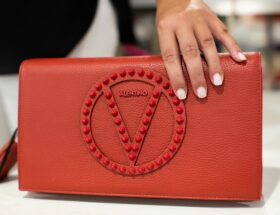Guest post by Andrea Bertinetti
Summer wear has a storied history; but not as long as you might expect.
1. There was no such thing as ‘summer wear’ until the 1920s.
The idea of recreational travel and holidays didn’t become a thing until the late 19th century when public transportation like trains and passenger ferries made it possible. Later, the car and the passenger plane arrived, and these allowed even more people to travel as they pleased.
Without holidays, there was thought to be no need for a distinct set of warm weather clothes. Look at pictures of the earliest holidaymakers, such as Victorian seaside visitors in England, and you’ll see them dipping their toes in the water dressed in layers and layers of clothing. Heavy petticoats, corsets and full-length skirts were standard.
Fast forward a few decades and the popularity of travel created a demand for more comfortable clothes for holidaying. In the 1920s, wealthy actresses and socialites began to travel further afield to places like Cannes, Biarritz and Palm Beach. Their luxurious lifestyle was frequently documented by the media. They were pictured in what came to be known as ‘resort wear’.
These images of the most glamorous fuelled a fever for shorts and sun tops, chambray skirts and lighter jackets. This was also the beginning of the capsule wardrobe: a set of mix and match garments, perfect for traveling light.
2. The sundress, as we know it, didn’t appear until the 1940s.
Despite a new love for resort wear in the 20s and 30s, the sundress wasn’t popular at first. Separates were the thing. But, by the end of the 1950s, the summer dress had become a distinct garment and it was popular, too.
The late 40s and early 50s were the time of a boom in fashion, particularly in the West.
World War 2 was over and economies were recovering. The women who had worked during the war while the men fought were more likely to be back at home. This time is reflected in fashion; brighter, more frivolous clothing was becoming popular. Hence, the cool, breezy sundress was born.
3. Lilly Pulitzer’s famous sundress was originally designed to hide stains.
Lilly Pulitzer is a name that is frequently associated with the advent of the sundress. This lady was a stylish hostess and socialite whose husband owned several Florida orange groves.
Circa 1959, Lilly found herself bored and in need of her own project. So she set up a juice stand in Palm Beach. The venture was soon a big success and Lilly enjoyed being hands-on, squeezing juice herself. However, she had an issue. The pristine white dresses popular at that time were not compatible with life in a juice bar. They were getting ruined.
Not to be defeated, Lilly commissioned her dressmaker to design some dresses that would hide the stains. The results were bright shift dresses in pinks, yellows, greens, and oranges. Soon, these attracted more attention than her juices.
Lilly saw a big opportunity. Before too long, she gave up on juice and instead focused on selling her dresses. This was to prove a turning point. Lilly’s sundresses were a big hit and suddenly ladies’ summer fashion was a whole lot brighter from that moment on.
4. Nobody knows exactly where the ‘no white after labor day’ rule comes from.
It’s popular in many cultures to wear white during the warmest months. This is for practical reasons: white deflects heat from the sun and helps keep the wearer cooler.
While it’s barely followed now, there’s a tradition in the USA that expects everyone to put away their white clothes after Labor Day. This holiday falls early in September. The same tradition expects white to not come out until Memorial Day in late May. Many warm days will fall outside of this period, so where is the logic?
Nobody quite knows. Some say white was once worn by New York’s wealthy elite as a status symbol. They would wear white while enjoying their Long Island summer vacations in July and August. Then, on their return to the city, white garments would return to their closets as a mark of the end of their summer.
In today’s day and age of global travel and breaks throughout the year, this rule seems to come from a bygone age. Yet, it is still a phrase and fashion ‘rule’ you may encounter at some point. In reality, people enjoy white in their wardrobes all year round wherever they are.
5. The ‘Summer of Love’ changed fashion forever
The summer of the year 1967 is known as the ‘Summer of Love’. This marked the beginning of a huge cultural movement, when the young freed themselves from the shackles that had inhibited previous generations and began their search for free love.
The fashion of the day is instantly recognizable. Bohemian blouses, flared jeans, tie-dye and embroidery; this was a generation who were making their own clothes.
However, it didn’t take fashion designers long to join the movement. Lots of designers drew inspiration from the hippy trend. YSL’s 1976 collection, in particular, is considered to be a pivotal moment in fashion history. From this moment on, the bohemian look has been a regular on the catwalk.
Today, bohemian styles are integral to many summer collections, including Scarlett Poppies’ sunstone collection. This look embodies fun, adventure and free-spiritedness. Yet there is attention to detail with intricate embroidery and exquisite fabrics. It’s the romance of this style that makes it utterly timeless.
Today’s summer wear collections are truly global
It seems fitting that global travel is the influence for some of today’s most beautiful summer wear collections.
They draw their inspiration from an eclectic mix of destinations: Japanese-style kimonos and Middle-Eastern kaftans are the ideal basis for cool, comfortable beach cover-ups. European-style jumpsuits and high-waisted shorts are added for chic summer looks.
Then there’s the maxi dress, the first of which is attributed to Oscar de la Renta in the USA of the 1960s. This is a look that has been reinvented many times. The maxi skirt and peasant blouse are also popular styles every summer.
What draws these looks altogether is their easy, breezy style. Lightweight fabrics that flow in the breeze keep their wearer cool and comfortable.
Today, summer and resort wear needs to look stylish but it also must be practical and comfortable, never detracting from everyone’s enjoyment of the fun, favorite days of the year.
-----------------------
AUTHOR BIO
Andrea Bertinetti is the Marketing Manager at Scarlett Poppies, a vivacious Dubai-based resort and beachwear brand that offers edgy, easy-breezy and effortlessly cool pieces designed by a cultural melting pot of designers. Influenced by tribal trends with a touch of Scandinavian flair, the brand's beachwear styles are always ethereal and minimalistic.



